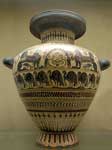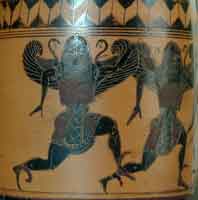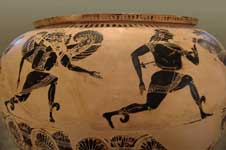.

Perseus ? killing the Gorgon Medusa ? . Archaic Laconian Ivory Plaque
In Greek mythology, the Gorgons ("terrible" or, according to some, "loud-roaring") were vicious female monsters with sharp fangs and hair of living, venomous snakes.
Classical tradition
Gorgons are sometimes depicted as having wings of gold, brazen claws, and the tusks of boars. According to the myths, seeing the face of a Gorgon turned the viewer to stone. Homer speaks of only one Gorgon, whose head is represented in the Iliad as fixed in the centre of the aegis of Zeus:
"About her shoulders she flung the tasselled aegis, fraught with terror...and therein is the head of the dread monster, the Gorgon, dread and awful, a portent of Zeus that beareth the aegis."(5.735ff)
Its earthly counterpart is a device on the shield of Agamemnon:
"...and therein was set as a crown the Gorgon, grim of aspect, glaring terribly, and about her were Terror and Rout."(11.35ff)
In the Odyssey, she is a monster of the underworld:
...and pale fear seized me, lest august Persephone might send forth upon me from out of the house of Hades the head of the Gorgon, that awful monster..."(11.635)
Hesiod (Theogony, Shield of Heracles) increases the number of Gorgons to three -- Stheno (the mighty), Euryale (the far-springer) and Medusa (the queen), and makes them the daughters of the sea-god Phorcys and of Keto. Their home is on the farthest side of the western ocean; according to later authorities, in Libya. The Attic tradition, reproduced in Euripides (Ion), regarded the Gorgon as a monster, produced by Gaia to aid her sons the giants against the gods and slain by Athena. Of the three Gorgons, only Medusa is mortal.
According to Ovid (Metamorphoses), Medusa alone had serpents in her hair, and this was due to Athena (Roman Minerva) cursing her. Medusa had copulated with Poseidon (Roman Neptune), who was aroused by the golden color of Medusa's hair, in a temple of Athena. Athena therefore changed the enticing golden locks into serpents. Aeschylus says that the three Gorgons had only one tooth and one eye between them (see also the Graeae), which they had to swap between themselves.
Other sources claim that each of three Gorgon sisters, Stheno, Euryale, and Medusa had snakes for hair, and had the power to turn anyone who looked at them to stone. Apollodorus (11.2.6, 2.4.1, 22.4.2) provides a good summary of the Gorgon myth, while Pausanias (5.10.4, 8.47.5, many other places) supplies the details of where and how the Gorgons were represented in Greek art and architecture.
According to Ovid (Metamorphoses), Medusa alone had serpents in her hair, and this was due to Minerva (Athena) cursing her. Medusa had copulated with Neptune (Poseidon), who was aroused by the golden color of Medusa's hair, in a temple of Minerva. Minerva therefore changed the enticing golden locks into serpents. Aeschylus says that the three Gorgons had only one tooth and one eye between them (see also the Graeae), which they had to swap between themselves.
Perseus and Medusa
Medusa was the only one of the three who was mortal; hence Perseus was able to kill her by cutting off her head while looking at her in the reflection in a mirrored shield he got from the Graeae. Some authors say that Perseus was armed with a scythe by Mercury (Hermes) and a mirror by Minerva (Athena). Whether the mirrored shield or the scythe, these weapons allowed him to defeat Medusa easily. From the blood that spurted from her neck sprang Chrysaor and Pegasus(other sources say that each drop of blood became a snake), her two sons by Poseidon. He gave the head, which had the power of turning into stone all who looked upon it, to Athena, who placed it in her shield; according to another account, Perseus buried it in the marketplace of Argos.

Medusa, after 1590, by Caravaggio
Protective and healing powers
A gorgoneion (or stone head, engraving or drawing of a Gorgon face, often with snakes protruding wildly and tongue sticking out between the fangs) was frequently placed on doors, walls, coins, shields, breastplates, and tombstones in the hopes of warding off evil. In this regard gorgoneia are similar to the sometimes grotesque faces on Chinese soldiers’ shields, also used generally as an amulet, a protection against the evil eye. In some cruder representations, the blood flowing under the head can be mistaken for a beard.
In Greek mythology, blood taken from the right side of a Gorgon could bring the dead back to life, yet blood taken from the left side was an instantly fatal poison. Athena gave a vial of the healing blood to Asclepius, which ultimately brought about his demise.
Heracles is said to have obtained a lock of Medusa’s hair (which possessed the same powers as the head) from Athena and given it to Sterope, the daughter of Cepheus, as a protection for the town of Tegea against attack.
According to the later idea of Medusa as a beautiful maiden, whose hair had been changed into snakes by Athena, the head was represented in works of art with a wonderfully handsome face, wrapped in the calm repose of death.

Origins
The concept of the gorgon is at least as old in mythology as Perseus and Zeus. The name is Greek, being from gorgos, "terrible." There are a few cognates: Old Irish garg, "wild", Armenian karcr, "hard". Hoffman's suggested root is *gragnis; Émile Boisacq's, *greg-. The root would not be a commonly used one.
The name of the most senior "terrible one", Medusa, is better Greek, being the feminine present participle of medein, "to rule over." The masculine, Medon, "ruler", is a Homeric name. The Indo-european root, *me-, "measure", generates a large number of words.
The name of "queen" and the magical powers indicate Medusa was a bronze-age deity, and yet deities are not beheaded by mortals and terrible ones are not really terrible if they ward away enemies. The snakes are reminiscent of the Cretan snake goddess. It is possible that the story represents the subordination of a pre-Greek religious infrastructure by new Greek superstructures able to attribute the power of life and death to themselves.
On the other hand, Marija Gimbutas ("Language of the Goddess") believed she saw the prototype of the gorgoneion in Neolithic art motifs, especially in anthropomorphic vases and terra cotta masks inlaid with gold. The gorgon descends from the pre-Indo-European goddess of life and death, represented in various forms, of which the gorgoneion is one.
The motif is an accretion of motifs. The large eyes, as well as Athena's flashing eyes, are a symbol termed "the divine eyes" by Gimbutas (who did not originate the perception), appearing also in Athena's bird, the owl. They can be represented by spirals, wheels, concentric circles, and other ways. They radiate the sun's rays and weep the spring rains.
Snakes also possess the eyes. The fangs of the gorgoneion are snakes' fangs. Snakes are a symbol of propitiation and increase. The round face is the moon. Sometimes gorgoneia are endowed with birds' feet or bee wings, more symbols of regeneration. The mouth is open so that streams may flow from it. The lolling tongue is a symbol of death.
It cannot be said that these motifs belong exclusively to the European Neolithic and not to the Indo-europeans. They appear among the Celts and Germans as well. The Balts kept snakes as household pets. As Gimbutas points out, masks with staring eyes are portrayed in Paleolithic cave art. Very likely, the goddess precedes any Indo-european/non-Indo-European distinction.
At Mycenae, traces of the ancient religion are found in elements considered characteristically Greek. A tholos tomb, there or elsewhere, is a symbol of the uterus. Solar discs studded the walls of some. The "death masks" of the shaft graves should probably more aptly be called life masks. In Paleolithic art, the dancer, who puts on a reindeer head with staring eyes, very likely became the reindeer in the dance. Similarly, a masked corpse overcame death by putting on the mask of life, a different concept from our death mask.
Gimbutas cites gorgoneia with bees' heads on some classical Attic pottery and with bees'heads, snake heads or owl faces on some Cycladic pottery. She regards them as transitional between the ancient and classical gorgoneia. As for the name, it is not from a solid Indo-European root. It could have been from a more ancient language, or could have translated a word in another language.
In Greek myth, only Perseus and Zeus (through Athena) own the gorgoneion. The two must be tied together in some way; that is, the king of Mycenae was the earthly counterpart of Zeus from whom he derived his authority. The Iliad clearly expresses this divine right of bronze-age kings, which the wrath of Achilles undermined. By assuming the gorgoneion, Perseus put on as a mask the power of life and death personified by Medusa, the cosmic queen.
Phinney Jr., Edward (1971). "Perseus' Battle with the Gorgons". Transactions and Proceedings of the American Philological Association 102: 445-463. DOI:10.2307/2935950. Retrieved on 2007-05-05.
| Ancient Greece
Science, Technology , Medicine , Warfare, , Biographies , Life , Cities/Places/Maps , Arts , Literature , Philosophy ,Olympics, Mythology , History , Images Medieval Greece / Byzantine Empire Science, Technology, Arts, , Warfare , Literature, Biographies, Icons, History Modern Greece Cities, Islands, Regions, Fauna/Flora ,Biographies , History , Warfare, Science/Technology, Literature, Music , Arts , Film/Actors , Sport , Fashion --- |
Retrieved from "http://en.wikipedia.org"
All text is available under the terms of the GNU Free Documentation License





